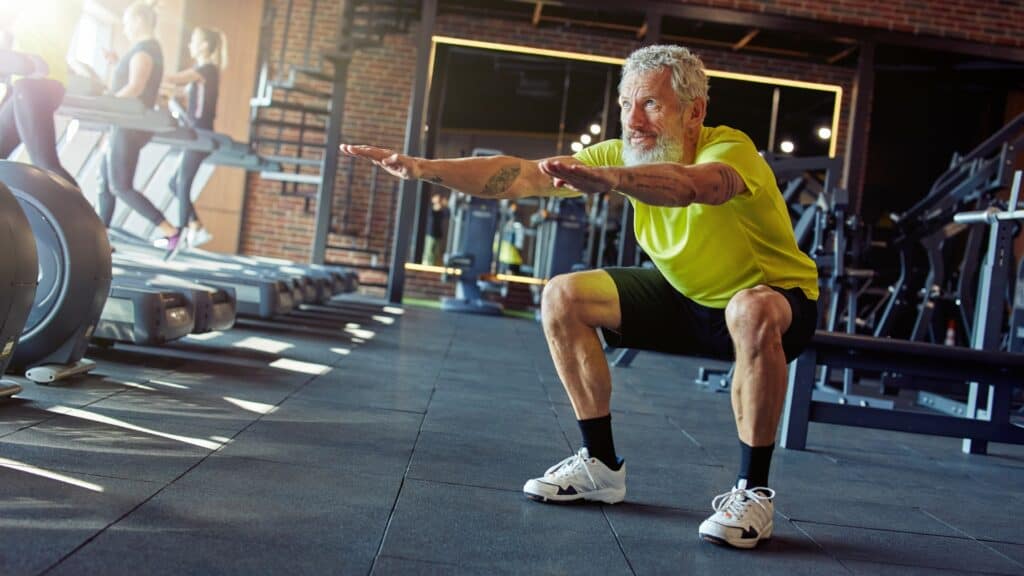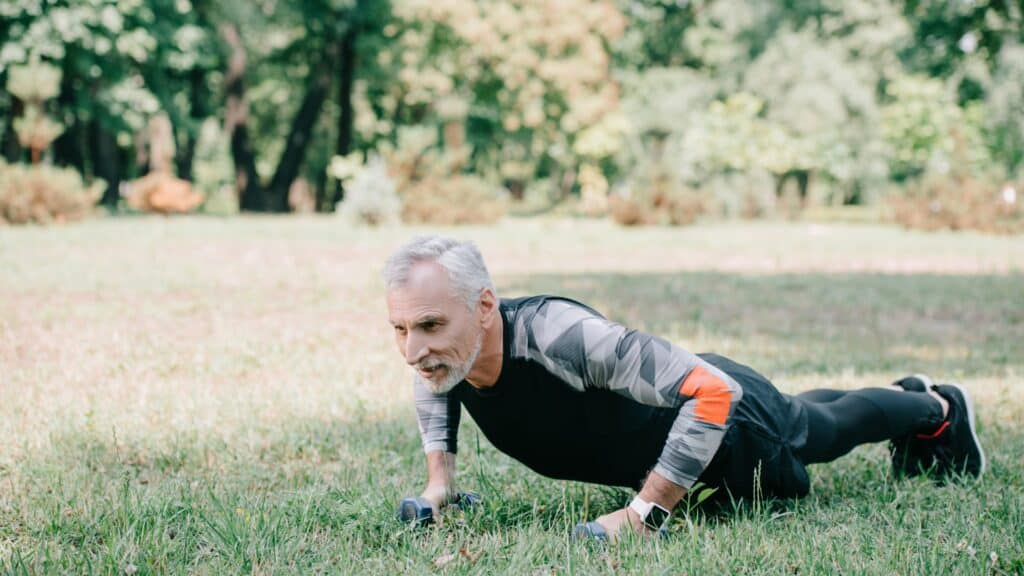As we age, our body naturally loses muscle mass and strength. This makes it difficult for runners over 50 to maintain their performance levels, especially as they push their bodies to run longer distances.
Runners should incorporate strength training into their workout routine – to prevent injury, improve running economy, and increase their overall strength.
But what kind of strength training should they focus on, and when should they do it?
In this blog post, we’ll explore why strength training is important for runners over 50, what exercises they should be doing, and when they should incorporate strength training into their running routine.
Let’s get started…

Why Strength Training Is Important for Runners Over 50
- Counteract Age-Related Muscle Loss
As we grow older, our body undergoes several changes, including a natural decline in muscle mass and physical capabilities. This is particularly evident in individuals between 60 and 70 years old, who can lose up to 30-40% of their muscle mass.
This age-related decline can lead to reduced mobility, an increased risk of falls, and a lower quality of life.
However, numerous scientific studies have found that strength training, especially resistance exercises such as weight lifting, can effectively combat this decline in muscle mass.
These exercises stimulate muscle protein synthesis, which helps promote the growth and maintenance of muscle mass. With regular resistance training, we can help preserve muscle health, strength, and overall well-being as we age.
In addition to improving running performance, strength training plays a crucial role in supporting overall mobility and reducing the risk of injuries.
By building and maintaining muscle mass, we can improve our balance, coordination, and flexibility. This, in turn, can help us stay active and independent as we age, leading to a better quality of life.
Over the years, I have managed to convince my father how important strength is.
There are periods however that he tends to neglect strength. Being 74 is amazing how quickly he regresses and over the last 3 years, whenever he has fallen, the 1st question I ask is: Are you doing your strength?
And if he’s fallen while running, the answer is always no. He really doesn’t fall ever IF he is consistent with strength.
- Maintaining Running Performance
As a runner, it is essential to maintain your muscle mass to improve your performance and prevent injuries.
Running is a high-impact activity that puts significant stress on your joints and ligaments. Therefore, having strong muscles can help absorb the forces involved in running and reduce the strain on your body.
When your muscles are strong, they can better support your bones and joints, making it easier to maintain proper form and posture. Additionally, strong muscles can help reduce the risk of injuries such as shin splints, stress fractures, and tendonitis.
- Enhancing Overall Physical Resilience
Strength training is not just beneficial for building muscle mass but also has a positive impact on the health and stability of the connective tissues around joints.
This is because strength training forces the muscles to contract, and as a result, the connective tissues around joints are also put to work and become stronger. This enhanced joint stability helps reduce the risk of injury and can also improve overall joint health.
So, strength training can be a great way to not only build muscle but also promote joint health and stability.
- Improving Balance and Coordination
As we grow older, our bodies undergo several changes, including a decline in balance and coordination. This can make us more susceptible to falls and injuries, which can have severe consequences for our health.
However, strength training can be an effective way to help maintain these essential skills and reduce the risk of such incidents. By engaging in regular strength training exercises, seniors can improve their muscle strength, flexibility, and balance, which are all crucial components of good physical health.
Additionally, strength training has been shown to enhance bone density and reduce the risk of osteoporosis, a condition that weakens bones and makes them more susceptible to fractures.
To highlight what a difference strength can make, I went on a hike requiring me to carry supplies for myself and my children, including a tent, all weighing in at 28 kg (61 lbs). By the time we got to camp, I was shattered and unsure how I would manage the walk back.., Fast forward 6 months, many strength sessions later and I recently completed a hike with my son and his friends.
Not only did I easily carry my 25kg pack, but another Dad ran into problems and I have to carry both of our packs for over 2 miles (3.2km). I was amazed I could even do 1 mile like that!
- Hormonal Benefits
One of the most significant advantages of strength training is that it stimulates the natural release of hormones like testosterone and human growth hormone.
These hormones play a crucial role in muscle development and maintenance, as well as in overall health.
As we age, our bodies naturally produce less of these hormones, which can lead to a loss of muscle mass and a decline in overall health. However, by engaging in regular strength training exercises, we can stimulate the production of these hormones and help maintain our muscle mass as we age.
In addition to their role in muscle development, testosterone and human growth hormones also play a role in bone health, immune function, and metabolism. So, by engaging in strength training exercises, we can help promote overall health and well-being, particularly as we age.
- Recovery and Catabolic Balance:
Runners over 50 may find that their bodies no longer recover as quickly as they once did. This means that they may experience longer recovery times between workouts, which can disrupt their training routine and hinder progress.
However, strength training can help improve their recovery rates. By building stronger muscles and increasing their overall physical resilience, older runners can maintain a more consistent training plan and continue to pursue their passion for running with greater ease and comfort.
When we engage in activities like running, our body goes into a catabolic state, which means that it starts breaking down muscle tissue to provide energy to the body. This can lead to muscle loss and a decrease in overall strength and endurance.
That’s why it’s important to balance catabolic activities like running with anabolic activities like strength training. Strength training helps to maintain muscle tissue and even promote muscle growth, which can help offset the muscle breakdown caused by running.
- Flexibility and Mobility
As runners age, the natural decrease in range of motion can lead to reduced mobility and increased injury risk. To counteract these effects, older runners should prioritize exercises that focus on flexibility and mobility, such as dynamic stretching and foam rolling.
By maintaining proper running form and reducing the risk of injury, these exercises can help older runners continue to enjoy the many benefits of running for years to come.
- Mental and Emotional Benefits
It can be difficult to maintain our running goals as we age because our muscles tend to weaken and lose mass. But strength training can significantly help us continue our running pursuits.
Strength training exercises can increase muscle mass, improve bone density, and enhance joint stability, leading to more power and endurance during runs.
This can also contribute to a sense of accomplishment and boost mental health, as older runners can continue to enjoy the benefits of running and feel more confident about their physical abilities.

What Exercises Should Runners Over 50 Focus on?
- Bodyweight Exercises: These include squats, lunges, and push-ups. These exercises are fundamental for building strength and don’t require any special equipment. They are effective at targeting key muscle groups that are essential for running.
- Resistance Band Workouts: Using resistance bands can help build muscle without putting additional pressure on the joints. Exercises could include leg lifts, lateral leg raises, and upper-body workouts.
- Strength Training with Light Dumbbells: Starting with light dumbbells for exercises like bicep curls, overhead presses, and weighted lunges can be beneficial. This allows for a gradual increase in strength without overstraining.
- Stability and Flexibility Exercises: Given the importance of maintaining a good range of motion and preventing injuries, stability exercises (like balance training) and flexibility workouts (such as yoga or stretching routines) would be important.
- Core Strengthening: Exercises that strengthen the core, like planks or abdominal crunches, are crucial as they support the runner’s posture and overall stability.
- Low-Intensity Cardio: Apart from strength training, incorporating low-intensity cardio exercises like walking or gentle jogging can maintain cardiovascular fitness without overly stressing the body.
Making sure you do the correct strength training is important. The good news is we’ve created a free strength training plan for runners that you can download by clicking here.
When it comes to starting strength training, it is crucial to remember that taking things slow and gradually building up your strength is key–especially if you’re new to this type of exercise.
Starting too fast or with too much intensity can lead to injury and long-term setbacks. Therefore, it’s important to start with light weights or bodyweight exercises and gradually increase the weight or resistance over time. This will allow your muscles, joints, and ligaments to adapt and strengthen, reducing the risk of injury.
Additionally, listening to your body and working within your limits is essential. If something feels painful or uncomfortable, it’s important to stop and reassess before continuing. By taking a patient and gradual approach, you’ll be able to build strength safely and effectively over time.
It’s important to gradually increase the intensity of workouts. This can be achieved by adding more reps, increasing weight, or incorporating more challenging variations of exercises over time.
For runners over 50, it’s crucial to prioritize a balanced approach that includes strength, flexibility, and stability. In addition, it’s important to keep in mind that longer recovery times and a reduced range of motion may be necessary.
If you’re starting a new exercise routine or making significant changes to an existing one, it’s always recommended to seek the advice of a fitness professional.

When Should Runners Over 50 Incorporate Strength Training?
It’s hard to give a one-size-fits-all answer, as the frequency of strength training you need will depend on your fitness goals and schedule. However, it’s generally recommended to start with once-a-week sessions and then gradually increase to twice a week and potentially up to three times a week.
It’s important to increase gradually to allow your body to adapt and avoid overexertion, especially if you’re new to strength training.
Is There Anything Runners Over 50 Need To Do Differently In Their Strength Training Compared To Younger Runners?
When it comes to strength training, using the correct technique is absolutely crucial in order to prevent injuries and maximize the benefits of your workout.
Poor form or improper technique can put unnecessary strain on muscles, joints, and ligaments, which can lead to discomfort, soreness, and even long-term injuries. That’s why it’s important to work with a qualified trainer or coach who can guide you through the proper technique for each exercise, ensuring that you’re engaging the right muscles and moving in a safe and effective way.
For older athletes, there are some additional considerations to keep in mind. As we age, our range of motion may become more limited, making it harder to perform certain exercises with the same ease and fluidity that we might have had in our youth.
This is where stability and flexibility come in. By focusing on exercises that improve our balance, coordination, and joint mobility, we can help maintain our overall health and well-being, even as we get older.
This might include exercises like yoga, Pilates, or resistance band work, all of which can help to improve our stability, flexibility, and strength over time.

Are There Any Specific Risks Associated With Strength Training, Especially For Older Runners?
Engaging in strength training can be highly beneficial for individuals looking to build muscle, increase bone density, improve their overall physical health, and boost their metabolism. However, it is important to note that there are inherent risks involved with this type of training.
To minimize the risk of injury, it is crucial to employ the correct technique and maintain proper form throughout each exercise.
For older athletes, in particular, it is recommended to place a greater emphasis on stability and flexibility training. This is because aging can lead to a reduction in range of motion and flexibility, which can increase the risk of injury if not compensated for properly.
Related: Running When You’re Over 50 – Is It Good For You?
Strength training is an essential component of any runner’s training routine, especially for those over 50. By incorporating exercises that target the muscles used while running, runners can prevent injury, improve their running economy, and increase their overall strength and resilience.
It’s important to start with lighter weights and gradually increase the intensity and volume of your workouts to avoid injury, and to find a strength training schedule that works for you.
With consistent strength training, runners over 50 can continue to run at their best for years to come.



Comments are closed.